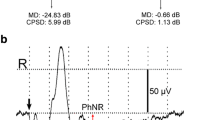Abstract
In the past five years numerous reports have suggested that ganglion cell function can be tested by means of a specialized form of electroretinography, the socalled pattern electroretinogram (PERG). Because of the important potentials of a ganglion cell test for clinical use this technique has been applied by several investigators to patients with (presumed) ganglion cell dysfunction, especially glaucoma. On grounds of principle we had reason to question whether the reported positive results should be attributed to ganglion cell dysfunction or to other factors such as optical disturbances. We investigated in this study the PERG as a function of visual field loss in glaucoma patients with careful control of optical factors. We did not find changes in PERG as a function of field loss. So either field loss is not related to the mass behaviour of ganglion cells, or ganglion cells are not the prime basis of the PERG. We believe the latter to be true.
Similar content being viewed by others
References
Arden GB and Vaegan (1983) Electroretinograms evoked in man by local uniform or patterned stimulation. J Physiol 341:85–104
Arden GB, Carter RM, Hogg C, Siegel IM and Margolis S (1979) A gold foil electrode: Extending the horizons for clinical electroretinography. Invest Ophthal Vis Sci 18:421–426
Bobak P, Bodis-Wollner I, Harnois C, Maffei L, Mylin L, Podos S and Thornton J (1983) Pattern electroretinograms and visual-evoked potentials in glaucoma and multiple sclerosis. Amer J Ophthal 96:72–83
Dagnelie G (in preparation) Use of a high frequency digital display as a versatile visual stimulator
Dawson WW, Trick GL and Litzkow CA (1979) Improved electrode for electroretinography. Invest Ophthal Vis Sci 18:988–991
Fiorentini A, Maffei L, Pirchio M, Spinelli D and Porciatti V (1981) The ERG in response to alternating gratings in patients with diseases of the peripheral visual pathway. Invest Ophthal Vis Sci 21:490–493
Hess RF and Baker CL (1984) Human pattern-evoked electroretinogram. J Neurophysiol 51:939–951
Korth M (1983) Pattern-evoked responses and luminance-evoked responses in the human electroretinogram. J Physiol 337:451–469
Korth M and Rix R (1984) Effect of stimulus intensity and contrast on the pattern ERG. Ophthal Res 16:60–66
Leydhecker W (1973) Glaukom: ein Handbuck, 2 Druck.. Berlin, Springer
Lith G van, Ringens P and Heer LJ de (1984) Pattern electroretinogram and glaucoma. In: Developments in ophthalmology, 9:133–139, ed: W Straub. Basel, Karger
Maffei L and Campbell FW (1970) Neurophysiological localization of the vertical and horizontal visual coordinates in man. Science 167:386–387
Maffei L and Fiorentini A (1981) Electroretinographic responses to alternating gratings before and after section of the optic nerve. Science 211:953–954
May JG, Ralston JF, Reed JL and Dyk HLK van (1982) Loss in pattern-elicited electroretinograms in optic nerve dysfunction. Amer J Ophthal 93:418–422
Papst N, Bopp M and Schnaudigel OE (1984a) Helligkeits- und Muster-ERG bei fortgeschrittenem Glaukom. Klin Mbl Augenheilk 184:199–201
Papst N, Bopp M and Schnaudigel OE (1984b) The pattern evoked electroretinogram associated with elevated intraocular pressure. Graefe's Arch Clin Exp Ophthal 222: 34–37
Riemslag FCC, Ringo JL, Spikreijse H and VerduynLunel H (1983) The distinction between luminance and spatial contrast components in the pattern ERG. Docum Ophthal Proc Ser 37:255–264
Riemslag FCC, Ringo JL, Spekreijse H and Verduyn Lunel HF (1985) The luminance origin of the pattern electroretinogram in man. J Physiol (in press)
Sokol S, Jones K and Nadler D (1983) Comparison of the spatial response properties of the human retina and cortex as measured by simultaneously recorded pattern ERGs and VEPs. Vision Res 23:723–727
Spekreijse H, Estévez O and Tweel LH van der (1973) Luminance responses to pattern reversal. Docum Ophthal Proc Ser 2:205–211
Spekreijse H, Dagnelie G, Maier J and Regan D (1985) Flicker and movement constituents of the pattern-reversal response. Vision Res (in press)
Wanger P and Persson HE (1983) Pattern-reversal electroretinograms in unilateral glaucoma. Invest Ophthal Vis Sci 24:749–753
Author information
Authors and Affiliations
Rights and permissions
About this article
Cite this article
Van Den Berg, T.J.T.P., Riemslag, F.C.C., De Vos, G.W.G.A. et al. Pattern ERG and glaucomatous visual field defects. Doc Ophthalmol 61, 335–341 (1986). https://doi.org/10.1007/BF00142361
Issue Date:
DOI: https://doi.org/10.1007/BF00142361




